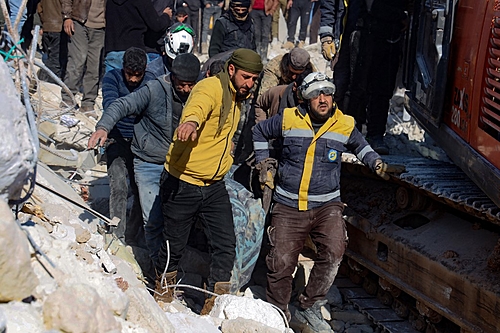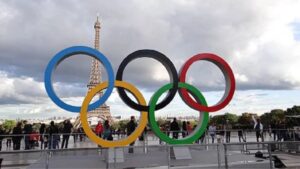
Authorities in Turkey and Syria reported this Wednesday (08) that the death toll from the earthquake that hit the border region between the two countries on Monday morning has passed. It is the deadliest earthquake to hit Turkey since 1999.
The magnitude 7.8 tremor on the Richter scale shook southeast Turkey and northwest Syria. The Turkish government said the death toll had exceeded 9,000. On the Syrian side of the border, the death toll has already reached nearly 3,000, according to country officials quoted by the Reuters news agency.
Rescue teams race against time to pull people out of the rubble, and the chances of finding survivors dwindle by the hour. The number of wounded exceeds 50,000, and the number of dead is expected to continue to rise.
The quake struck at 4:17 am (local time) on Monday, and its epicenter was near the provincial capital of Gaziantep, a major industrial center in southeastern Turkey. According to the United States Geological Survey (USGS), the epicenter occurred at a depth of 18 kilometers. The initial quake was followed by dozens of aftershocks, including a magnitude 7.5 aftershock.
The initial 7.8 earthquake on Monday was also felt in the Turkish capital Ankara, Lebanon, Cyprus and even the Egyptian capital Cairo. Thousands of buildings collapsed over a wide area of hundreds of kilometers, from northern Syria – the scene of a civil war for almost 12 years -, in cities like Aleppo, to southeastern Turkey, where the largest city in the region was affected. Diyarbakir. Rescue teams search for survivors in the rubble.
It is estimated that around 23 million people were affected by the earthquake between Turkey and Syria / Adem Altan / AFP
The World Health Organization (WHO) believes that the death toll should rise significantly due to the large number of damaged buildings, and could reach around 20,000 in the coming days.
WHO Regional Emergency Representative for the Eastern Mediterranean Rick Brennan said the UN agency had sent reinforcements to its team in Gaziantep and said rescue work had been hampered by the aftershocks.
Regarding Syria, Brennan stated that the earthquake is yet another tragedy that adds to the humanitarian crisis that affects the country, which is facing serious economic problems and an outbreak of cholera. “The convergence of all these crises is causing enormous suffering.”
Under Syrian regime control, the city of Aleppo recorded several aftershocks. DW managed to speak via WhatsApp messages with a 30-year-old resident who declined to be named for security reasons.
“Most of the people who are helping to pull people out of the rubble are civilians. Most of them are not trained to carry out rescue work. It is very dangerous. At any moment, they can be buried”, explained the witness, who said he felt the earth shake all the time. “Maybe it’s just my body too, I’m in shock.”
“We urgently need blood donations. Everyone here has already been asked to donate blood because the number of wounded increases all the time”, he described. “People here in Aleppo have been asked to leave their homes, but hardly anyone has left. They don’t know where to go and they don’t have the money to stay in a hotel either,” she said.

After three days of rescue work, thousands of people are still missing among the rubble in Syria and Turkey / Louai Beshara / AFP
rescue work
In Turkey, the government declared a state of emergency in ten provinces. Low temperatures and snow in the region, where there are also mountainous territories that are difficult to access, make rescue work difficult.
Videos posted on social media showed destroyed buildings in several cities in the south-east of the country. State broadcaster RTR showed rescue efforts in Osmaniye province, which are racing against time to search for survivors in the rubble.
Turkish President Recep Tayyip Erdogan said he was in contact with local authorities in the affected regions to inquire about the situation. “I hope we can overcome this disaster together as soon as possible and with minimal damage,” Erdogan said on social media.
The earthquake, according to Erdogan, is one of the most devastating in recent Turkish history. “It is the second strongest since the 1939 Erzincan earthquake,” he added.
The president said that landslides or serious damage were recorded in more than 6,400 residential properties. One of the symbols of the earthquake’s massive destruction is the historic Roman castle of Gaziantep, which had been erected over 1,700 years ago. CNNTurk showed images of the severely damaged castle.

The Syrian city of Jindais was left under rubble after the earthquake passed / Aaref Watad / AFP
“Tragic Situation”
In Syria, in civil war for more than a decade, the hardest hit provinces were Hama, Aleppo and Latakia. The devastated zone is divided between territory controlled by the regime in Damascus and the last enclave in the hands of the opposition, which is surrounded by government forces, supported by Russia.
“The situation is very tragic, dozens of buildings have collapsed in the city of Salqin,” said a member of the White Helmets, a Syrian rescue organization, in a video posted on social media. The mentioned city is five kilometers from the border with Turkey.
“Whole families are buried and the White Helmets are unable to reach them. There is a lack of equipment to rescue survivors in different places at the same time,” said Omar Albam, a DW reporter in Syria. “At the moment, there is no reliable estimate on the number of dead. Chaos dominates everything and it is still confused,” he said.
According to Albam, the small town of Samada, 30 kilometers from Idlib and close to the border with Turkey, was one of the hardest hit by the earthquake in the country. The city would have been completely destroyed by the earthquake. But also the town of Jindires, 20 kilometers southwest of Afrin, was hit hard, with severe damage to internet and cell phone connections.
Syrian President Bashar al-Assad held an emergency cabinet meeting to assess the damage and discuss measures to be taken.
Syrian state broadcaster showed footage of rescuers searching for survivors in the rubble amid heavy rain and hail. Many buildings in the affected region had already suffered damage due to the civil war in the country that has lasted almost 12 years.
international aid
Several countries offered help to the affected region. The European Union (EU) has said it will send at least ten rescue teams to Turkey. European Commissioner for Crisis Management Janez Lenarcic said Brussels had activated the bloc’s Civil Protection Mechanism. Teams from the Netherlands, Romania, Croatia, the Czech Republic, France, Greece, Bulgaria and Poland have already been deployed to the affected area.
The head of EU diplomacy, Josep Borrell, stressed that the European bloc is “ready to help” the countries affected after a “devastating” earthquake, which “has already claimed the lives of hundreds of people and injured many more”.
Germany sent emergency aid and first-aid supplies, including shelters and water treatment plants. The United States, on the other hand, mobilized a team of specialists in disaster response. Italy and Hungary also offered help.
In all, at least 45 countries offered support, including India, China, Russia, Ukraine and Israel.
active seismic zone
Turkey is located in one of the most active seismic zones in the world. In November, a magnitude 5.9 earthquake hit the Turkish province of Düzce, 200 kilometers east of Istanbul, leaving at least 68 people injured.
In 1999, a magnitude 7.4 earthquake that hit Izmit left more than 17,000 dead. In 2011, an earthquake in the city of Van left 500 dead.
Source: www.brasildefato.com.br

